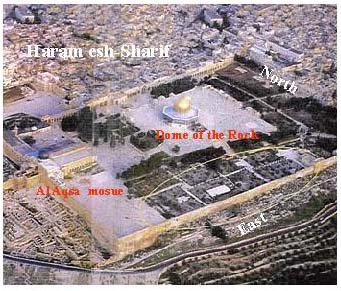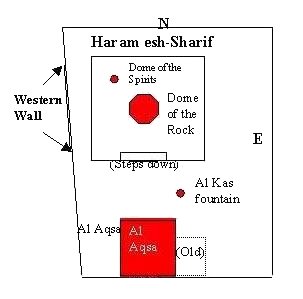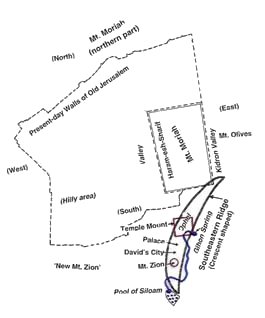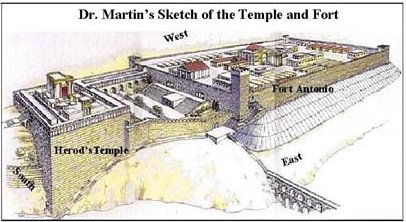
Hope of Israel Ministries (Ecclesia of YEHOVAH):
The Real Site of Herod's Temple in Jerusalem
|
In New Testament times the Haram esh-Sharif (Temple Mount) was the site of a Roman fort and a military camp called Fort Antonia. Ancient witnesses reveal that the Haram was indeed the Roman fort, and it was a large enclosed military camp -- some 36 acres in area. It was a miniature Roman city with its own administration, living quarters and temple structures to accommodate some 6,000 soldiers of the 10th Legion. The Jewish Temple itself was built above the Gihon Spring in the City of David so that the water could be drawn up for purification purposes. The Temple was to the north of David's city on a mound called Ophel. David's city itself was called the Citadel (Akra) -- a mound to the south, also called Mt. Zion. |
by T. V. Oommen
Virtually all maps of Jerusalem show the location of Herod's Temple of Jesus' time on the elevated rectangular walled-in space called Haram esh-Sharif which means Temple Mount. What do you see on the 'Temple Mount'? There is one structure standing prominently on it that can be seen from anywhere in Jerusalem, particularly from Mt. Olives on the eastern side. This is the Dome of the Rock, a Moslem shrine with beautifully inscribed octagonal walls and a gold covered dome, and is certainly the center piece of the Old City.
The popular view, supported by Jewish scholars, is that the Dome stands where the Holy of Holies of Herod's Temple was. Due to this belief, the high western wall of the Haram opposite to the Dome is revered by Jews who believe the bottom stone layers are Herodian (the top ones are Ottoman). Herod's Temple is referred to by the Jewish people as the Second Temple (the First one being Solomon's Temple), but we shall see later that this designation is not correct. The Western Wall is popularly called the 'Wailing Wall'. The temple entrance was from the east, so the Holy of Holies would be in the west.
Did the Jewish people always believe that the Haram (I shall use this shortened name for Haram esh-Sharif) was the real Temple Mount? The truth is, they have been holding this belief for only the last 800 years; the reverence to the Western Wall (wrongly called the 'Wailing Wall') started some 380 years ago. So where did they place the Temple site before that time? I shall reveal the true site in this article. One thing I can say now is that the Haram is NOT the true Temple Mount.

In recent years Jewish scholars and researchers have proposed other locations for the Temple, still on the Haram. It is necessary to briefly describe these sites.
Four Proposed Sites for the Temple
These sites are all on the Haram as already pointed out. Let me mention these sites and comment on them. The sketch below shows the four locations.

1. The Traditional Site
This is the site of the Dome of the Rock mentioned above. I shall give more details on the selection of this site. Dr. Ernest Martin's new book, The Temples That Jerusalem Forgot (ASK Publications, 2000) which I shall refer to again gives the following information. During the Crusader times when Jerusalem was occupied by the Crusaders, very few Jewish people were allowed to enter the city. One of them was Benjamin Tudela, a traveler from Tudela, northern Spain. From hearsay he wrote in 1169 that the Haram was the true site of the Temple. The Jewish scholars of the time including the renowned Maimonides insisted that it was not. Yet, we find that by the end of the 13th century there was not one single Jewish person that questioned Benjamin Tudela. The sanctity of the Western Wall was imprinted on Jewish minds by the Kabbalist leader Rabbi Isaac Luria of the 16th century who had made several erroneous place identifications. The modern scholars have redrawn ancient Jerusalem maps to suit these new ideas. Among them are Dr. Leen Ritmeyer and Dr. Dan Bahat. Ritmeyer claims he has found the exact spot where the Ark of the Covenant was placed on the Rock underneath the Dome (Bible Archaeology Review - BAR - article, March/April 1992 ). Bahat has published his map book, Cartas Historical Atlas of Jerusalem 1986). Ritmeyer even claims he has found on the Haram the boundaries of the 500 cubit square original platform of the Temple Mount mentioned in the Mishnah.
2. "Dome of the Tablets" (or "Spirits")
About 100 yards north west of the Dome is a small Cupola (which I have visited) where the bedrock has a small protrusion just underground. Dr. Asher Kaufmann (BAR, March/April 1983) thinks this was the spot of the Holy of Holies. The so-called 'Golden Gate' (a closed double gate also called 'Gate of Mercy') is directly east of this location, reinforcing the belief that the Temple entrance was in a line with the Temple itself.
3. The Al Kas Fountain
When we walk to the south from the platform on which the Dome stands, we go down some steps to a lower platform which is also extensive. At the southern end is the famed Al Aqsa mosque (the original mosque was built to the south of it by Caliph Omar, but was renovated and enlarged by later Moslem rulers). It stands north-south 262 ft long. Half way to the mosque from the steps is a round washing fountain (Al Kas). The Moslem pilgrims sit on the bench around it and dip their feet in the water flowing from the fountain. Tuvia Sagiv, an Israeli architect, researched the Temple location and selected this as the probable site. Why? He read ancient records and found that from Herod's palace on the west he could see the Temple court. But the Haram upper platform would be too high for him to watch the Temple court. He also considered the water supply from the Bethlehem hills brought by aqueduct to the Temple site. Again, the elevation would be too high. Then he realized that during the time of Hadrian, the Roman emperor who crushed the Jewish revolt in 135 AD had changed Jerusalem to "Aelia Capitolina". He completely destroyed all vestiges of the Temple and adjoining structures, and it is reported that he built a Roman temple of Jupiter on the site, with an equestrian statue of his in front. Sagiv assume the Haram was the true Temple Mount, so he conjectured how the Roman Temple complex would look like. Borrowing from the design of the Baalbek temple in Syria, Sagiv proposed that the Jupiter Temple was where the Al Aqsa mosque is now, and a hexagonal structure was at the northern end, exactly at the spot of the Dome now. Sagiv thinks that the location of this structure was the Herodian Fort Antonia which had been built to protect the Temple. Ancient records show the rock itself was some 75 ft raised from the ground, and Sagiv thinks an observation tower was on top of (which he considered Fort Antonia). The ground level around the Rock was raised by Herod, so the Rock would not have been so much elevated.
4. The Al Aqsa Mosque
This site was proposed by Nathan Kaplan (who lives in Texas) in 1998 (see web site, www.templemouint.org/kaplan). It is the site of the 'Old' Al Aqsa mosque on the southern part adjoining the southern wall that he has selected. He noticed that the ancient gates (the 'Double' and 'Triple' Gates to ascend from the south to the Temple Mount) can be matched much better at this location.
Why These Locations Are Wrong
The traditional site suffers from inadequate support from ancient records. The site of the Dome of the Rock was a Christian holy site when Caliph Omar first visited Jerusalem in 638 AD. Why was it holy? The Christians believed that the Rock was used as an elevated platform by Pontius Pilate, and Jesus stood before him upon this rock. Legends spread that Jesus' feet was imprinted on the rock (certainly a myth). Emperor Constantine had a Church built over the rock, called the Church of Holy Wisdom (same name given to the huge basilica in Constantinople). Caliph Omar showed no interest in acquiring this site (which did not have the Church at the time because the Persians had destroyed all Churches in Israel in 614). He went instead to build the Al Aqsa mosque (the old one, now replaced) on the southern end which he considered the new Temple of Solomon. As you will see later, it was not exactly on the site of Solomon's Temple, but somewhat close). It was Caliph Abd-el-Malik who built the Dome structure above the Rock (690 AD). Why did he build there? It is believed that the site was ideal as a magnificent shrine that can be seen from anywhere, and would outshine the Church of the Holy Sepulcher in Jerusalem. Soon, legends began to accumulate. Already the Al Aqsa mosque had been linked to Mohammed's Night Journey to heaven from the mosque. This legend was transferred to the Rock, which apparently resisted going up, and instead created a hollow space underneath. This cave can be seen by anyone visiting the Rock. It is a man-made cave carved out in later times.
The 'Dome of the Spirits' location has little historical support. Its lining up with the 'Golden Gate' is of no importance, because this Gate is not the ancient Golden Gate (also called the Gate Beautiful, Acts 3:2) of Jerusalem. It is of later origin, though still surrounded by legends that Christ entered the Temple on Palm Sunday through this Gate.
The Al Kas site is also unreliable. As we shall see later, Hadrian's Jupiter Temple was not on the Haram.
Finally, the Al Aqsa mosque site has to be rejected too because even Caliph Omar knew it was not the true site of the Temple. What Omar did was to go to the ruined Temple site covered with rubbish, clean up the place and recover a "foundation stone" which he brought to the Al Aqsa site to build his mosque (also called Mosque of Omar). Many still erroneously think that Omar cleaned up the site of the Dome of the Rock.
Clues to the True Temple Site
Dr. Ernest Martin, in his book, The Temples That Jerusalem Forgot cited above mentions several clues to the True location of the Temple. There are also clues that tell where it could not have been.
Where the Temple Could Not Have Been
Ironically, the very place everyone thinks the Temple was, Haram esh-Sharif, is the least likely location. In New Testament times, this place was a Roman fort and a military camp called Fort Antonia. Most sketches of the Haram of the first century shows this fort at the northwest corner of the Haram, with the Temple on the Haram itself. Ancient witnesses reveal that the Haram WAS the fort, and it was a large enclosed military camp, some 36 acres in area. There were smaller camps for the Roman soldiers in other parts of Herod's Jerusalem, but this was the main one. It was a miniature Roman city with its own administration, living quarters and temple structures. The elevated central rock was used as a platform for public functions by the governor, and Pontius Pilate used it during his stay at Jerusalem during the Passover week of AD 31, and Jesus appeared before him. That was why the Christians built a Church over it in Constantine's time.
The fact that the walls of this fort has still some 10,000 stones on its walls prove this was not the wall around the Temple. The Romans broke down every wall, and removed every stone, not only of the Temple, but also of its walls. The incentive for this destructive act was not just vengeance, but the greed for gold which had melted down the cracks as the Temple burned down. The Romans had no reason to destroy their own city because they were occupying it. In fact the Roman legions left Jerusalem only in 289 AD. Other reason for not choosing the Haram will be given below.
The Requirements for the True Temple Site
Based on eyewitness accounts, the Temple had to have the following features:
1. A Natural Spring
The Old Testament and other sources reveal that underneath the Temple was a source of spring water from a natural spring nearby, the Gihon Spring (mentioned by this name in 2 Chron. 32:30, probably named after one of the four rivers flowing out of the Garden of Eden; the Temple itself was God's abode, like the Garden). The location of this Spring is seen on ancient maps of Jerusalem, and is shown below in relation to the Haram. It was over 1,000 ft south of the present Dome of the Rock. There is no other natural spring in a five mile radius of Jerusalem. King Hezekiah built a tunnel to bring the waters of the Spring to David's City (2 Chron. 32.30), and the waters exited at Siloam Pool. The Temple was built above the Spring so that the water could be drawn up for purification purposes. The Gihon spring is mentioned by other ancient writers such as Aristeas, Philo and Tacitus. Nehemiah's Water Gate (Neh. 12) was directly opposite to the Spring.
2. At A Lower Level than the Haram
Eyewitnesses such as Josephus have stated that the Temple could not be seen from the north because it was obstructed by the Fort to the north which was at a higher elevation.
3. It was Close to David's City
Everyone admits David's city was on the southeast corner of Jerusalem, many hundreds of feet south of the Haram walls. The Temple was to the north of David's city on a mound called Ophel. David's city itself was called the Citadel (Akra), a mound to the south, also called Mt. Zion.

The True Site
The true site of the Temple site is shown in the map above in a square. The southeastern ridge had two summits, one on the south, and the other on the north. The Temple was located on the northern summit, the Ophel, and David's City was on the southern summit called Mt. Zion.. The lower land in between, called Millo, was raised up by Solomon who built his palace there. Hence Solomon's palace was very close to the Temple..
According to Josephus, Herod's Temple platform was a square of one stadia on each side (approx. 600 ft), the size of a city block. This was protected by high walls on all the four sides, but since the southeastern corner had to be raised much higher to bring it to the same level as the other sides, this corner was about 450 ft high (40 to 45 stories high!). This was the area where Jesus was brought by Satan and tempted to jump down (Luke 4:9). The northern wall about 160 ft high. It was an incredibly fortified Temple. In Solomon's time the Temple mount was a rectangle 150 ft x 500 ft (the 150 ft being north-south distance). The eastern wall was the one that Nehemiah repaired. During the Maccabean times, the temple mount was expanded to the north another 100 ft and the Temple was also moved north. Herod moved the temple still further north after expanding the temple mount to a 600 ft x 600 ft platform. The temple was located at the center line. There were boundary areas beyond the walls, which made the whole temple mount 750 ft x 750 ft (500 cubits square), this outer square being at an angle with respect to the inner square. It should be clear now that Herod's Temple was not the Second Temple as popularly believed.
Dr. Martin has made a reconstruction of Herod's Temple and Fort Antonia, and his sketch is reproduced here with his permission (as found in his recent book, The Temples That Jerusalem Forgot, ASK Publications. Web site: www.askelm.org.)

It can be seen from the illustration that Fort Antonia, the Roman Camp, was connected to the Temple mount by a double colonnade for access by soldiers. There were other entrances to the Temple mount through well protected gates. The "Golden Gate" was not directly east of the Temple mount, but was on the eastern connecting wall. The long porticos near the southern wall (also called Solomon's porches) were used for informal gatherings and temple related business. Jesus must have used these porches for his teaching.
How the Ancient Sites Were Lost
Why can't we locate the true temple site today? If you visit Jerusalem today, you will se nothing but flattened ground south of the Haram. There are some building structures and a few roads there, but nothing conspicuous. The destruction of the southeastern ridge upon which had stood Mt. Zion and Ophel (the Temple site) took place in two stages:
First, during Maccabean times, the Maccabean leader Simon the Hasmonean razed Mt. Zion to ground level. The reason for this was the Syrians had encamped in David's City during the reign of Antiochus Epiphanus and they were able to harass the worshippers going to the Temple. The Temple itself could not be defended because of the Syrian presence. Nevertheless, Judas Maccabees managed to regain control of Jerusalem from the hands of Antiochus, and he cleansed the Temple in 164 BC after Antiochus had completely defiled it with a pagan statue of Zeus in the Holy of Holies, and sacrifice of swine on the altar. Simon, the younger brother of Judas, gained complete authority over Jerusalem some twenty years later, and he decided that Mt. Zion should not exist anymore. So David's City and the underlying older cities (Jebus and Migdol Edar (Gen. 35:21) were completely removed to the bedrock. Simon then transplanted Mt. Zion to the present site of Mt. Zion on the southwestern part of Old Jerusalem, outside the southern city wall. The so-called David's Tomb (adjacent to the Crusader building of the Last Supper) is nothing but a transplant of the original David's Tomb location.
Simon then proceeded to rebuild the Temple. After this he built a fort north of the Temple, the Baris, to protect the Temple. It was this fort that was modified and enlarged by Herod as Fort Antonia (the present day Haram-esh-Sharif site).
The second phase of the destruction took place when the Romans destroyed Jerusalem and burned the Temple in 70 AD. The Romans made sure that not one stone stood upon another, and the Temple mount was completely leveled. There were scattered stones and pillars, of course. After the Jewish revolt in 135 AD, Hadrian built a Roman Temple of Jupiter at the Jewish Temple site and he had his statue there. It was Emperor Constantine who destroyed the Roman Temple complex.
The Jewish people were allowed to rebuild their Temple at the original site during the time of Constantine and Julian the Apostate. These were brief attempts that did not last due to Christian influence. The site became once again ruins. It was from the rubbish heap of these ruins that Caliph Omar recovered what he believed to be the "foundation stone" to build the Al Aqsa mosque (located on the southern end of the Haram).
Summary
The original city of Jerusalem was in the southeastern part of present day Jerusalem, on a crescent shaped ridge. The ridge had two mounds, one on the north and the other on the south. The Temple was built on the northern mound called Ophel, very near to the Gihon Spring. The southern mound was called Mt. Zion, upon which stood David's city. Solomon's palace was in between the two on raised ground. The walls around the square Temple platform were very high, the southwestern corner being about 450 feet high. In Herod's time Fort Antonia which is about 600 feet north of the Temple platform was connected to the Temple premises by a double colonnade bridge on the western side. The present Haram-esh-Sharif was the original location of Fort Antonia which was a Roman encampment. The rock protruding a the center was considered sacred by early century Christians because Jesus had stood on it before Pilate; there was a Christian Church above it in the fourth to sixth centuries, but the Moslem rulers built the Dome of the Rock on the site. Caliph Omar built the original Al Aqsa mosque on the southern end of the Haram as the 'new' Temple of Solomon. The Western wall of the Haram has no sacredness attached to it as present day Jews believe because it is the retaining wall of Fort Antonia and later modifications. The original sites of David's city and the Temple are completely lost due to the total removal of the southeastern ridge by Simon the Hasmonean who leveled Mt. Zion, and the Roman legions which destroyed the Temple.
More information on these items, please read Dr. Ernest Martin's monumental work, The Temples That Jerusalem Forgot (ASK Publications, 2000).
|
Hope of Israel Ministries -- Preparing the Way for the Return of YEHOVAH God and His Messiah! |
|
Hope of Israel Ministries |
 |
Scan with your Smartphone for more information |